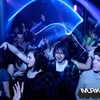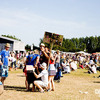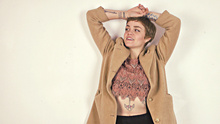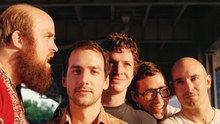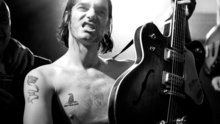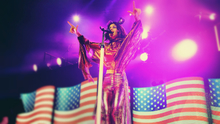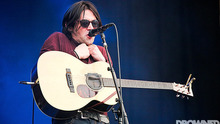It is often said that there exists a lack of high quality bands coming from the island known as Australia. Or rather, there aren't enough of them. That argument may have some saliency, but it's safe to say that Sydney and Melbourne electronica trio Midnight Juggernauts can't be lumped in with them. That's because they are actually quite good.
Theirs is a style which draws its influences and cues from many a genre and era. In 2007 they released their debut album, Dystopia, and now, in 2010, they return with The Crystal Axis, which is almost out now. You can get it digitally anyway. We caught up with drummer Daniel Stricker ahead of the band's appearance at Benicassim Festival to quiz him about the new record, found sounds, touring, festivals and the potential collaboration with Solange Knowles.
DiS: Your new record, The Crystal Axis, is just about to be released - how different is it to the first album?
Daniel Stricker: It's pretty different in the way that it's more a live sounding record. I think the first record has a lot more computer-based production and a bit more on top, but this one became more of a live record, just because we'd been touring so much. In 2008 we didn't come back to Australia and played the whole lot – festivals and road shows, so we got used more and more to being a live band and when we approached the record we started writing the songs from a jam environment. We explored different things that we've been wanting to do for a while – and when you're on tour and seeing different bands that influences you...I think we changed as musicians. It definitely sounds like us but it's more an evolution or a progression. It's not like a complete 180.
DiS: How much of it have you played live?
DS: Last year when we were working on the record, we tracked it in Australia and we brought in this guy from New York, Chris Moore, and he engineered it. Then when he went back to New York we kept working on it and tweaked things - we did that pretty much for the rest of the year. We'd go out and play shows – we even went to South America and road tested a couple of things. Some of the songs changed while we were playing but they've been changing and evolving all the time. I feel like we're getting a lot more comfortable with them now but it's been great being able to road test those songs because you can really see what's working and how the crowd's responding. Originally one of the singles we released – 'Vital Signs' – was seven minutes long and we'd played that and could see what was working and what wasn't. We changed the bridge a lot and pulled it back. We'd never had the opportunity to test stuff as much live, so we did that a fair bit.
But with these tracks they're so much more layered than the first record that for three people to try and do it live...there's a lot more analogue synths and samplers so taking that on the road has been a challenge, but a really good one because we've been putting electronic music where you can take it on these tangents. I think that's important because with electronic music you can get really stuck doing the same kinda grid-based music and even if it fucks up now and then it's important to try and make it interesting, not just for the audience but for yourselves. So throughout the process of writing the record and now playing it live that's been a key thing for us.
DiS: I guess you need the freedom to be able to have a bit more fun live because there's so much scope with that type of music...
DS: Exactly. And I think it's really easy to have a backing track and just play but I don't think that allows you to evolve, and once you start going off on tangents and reacting to the audience you learn as well, and when it comes to writing the next batch of songs, I think that's the only way for evolution. It's great for us Europe and the UK to start trying out all these new songs.
DiS: You been messing around with new gadgets?
DS: Yeah, when we made the record we came back from touring we bought a bunch of synths that we'd been looking at, so it was a lot more organic both in the process and the sound is too, because we were using a lot of old vintage synths. Personally I was exploring a lot of field recordings from the 1970s - like Cambodian music and rhythmic stuff like Gamelan music - just finding samples. So when we play now – we're obviously touring with a bunch of new toys – which allows us to replicate it live. There was a point when we were recording the new album where I was meant to go to Taiwan to try a field recording – we did a lot of our own percussive sounds in the studio – but we wanted to try and find something else, like Gamelan players that had these amazing instruments and sample that, but it fell through at the last minute, so we ended up using a lot of sample based stuff and a lot of our own percussion that we recorded. I guess live there's a lot more percussive stuff going on and that's obviously on the record.
DiS: There's clearly a whole lot of influences in your music which seem to meld very well together, but do you ever think – let's just do something like this, or like that, in one style or another?
DS: Well, definitely. There's things that we all really love. We all really connect on a level, we're listening to a lot of ELO or Brian Eno or Gerry Rafferty – these classic 70s pop artists because we love pop music first and foremost but each of us will bring a different take to that – whether that's exploring some sort of raw sound or whether it's the classic 70s from a production standpoint and melodic pop standpoint, and also we all really like groove based music. Although we approach stuff with traditional rock instruments we like the further afield - repetetive music or music that puts you in a trance, so those things are common influences. There's not just something we do but there is that improvised nature, probably more so on this record than the last.
DiS: Do you think you've learned much from the whole writing/recording/touring process from the first record, Dystopia?
DS: Yeah, definitely. The first one I was just working on a computer and doing stuff live on top but this was the other way around, but that has its own challenges and difficulties because there's going to be some mistakes and things that move around a little. That's the great part, though, because sometimes you have perfect imperfections and to work with electronic stuff on top of that it's probably more difficult. I think on the next record that'll probably be...somewhere different...just that whole recording technique we'd never thought about doing. The other thing I think we learned was working with so many textures...like on this record there are some tracks with over a hundred layers, just because we wanted to create this dense sounding ambience...I'd been listening to a lot of Bowie from the Berlin era. If you listen to 'Heroes', that's a classic pop track, one of his best, but there's a huge amount of ambience under the song and we really, really wanted to write these pop songs with that ambience. That was a real challenge trying to balance that in the mix, especially with pop music, because these days pop music is so much about the drums and vocals being up front, but we really wanted to make sure we didn't want to compromise our idea at the beginning of the record.
DiS: Do you think that using so many layers means you've got to learn to become a perfectionist even if you aren't usually one?
DS: I think you go in and put all these ideas down and sometimes they don't work together – it's really hard to balance a hundred things. So sometimes you'll say that's working and that's not working, sometimes it will make it just as dense with clarity and pulling things out. The hardest thing is knowing when to put in and when to take it out. If you're talking about being a perfectionist and trying to find a balance then that's the hardest thing, knowing when to stop, especially for us because we run our own label. We license it do different independent distributors but there's nobody breathing down out neck telling us that we have to do it that way or this way so it's just knowing what to put in and not put in...
DiS: How is the running of the label going at the moment?
DS: At the moment it's just our stuff but we've started talking to other people about putting records out, stuff that we've liked for a while and yeah we're going to start making that happen. I guess it's been hard at the moment because we've just been focusing on our own material and getting it out there because it's a lot of work. We have a team of people that we work with and then there's three of us. This last record we had it on our own label but we licensed it out through, so in some ways that was good and bad. It was good for us because coming from Australia it's hard to come into a territory that you've never been in really apart from putting your foot in and they helped us get the music out there. But this time we wanted to make sure we did the whole thing on our own label. It's a lot more work from our point of view but it allows you to get your creative vision over better. We're so heavily involved in the artwork – we do a lot of the artwork and even the videos it's a collaborative thing.
DiS: The video for 'Vital Signs' looks like it took a while – how involved were you in on the process?
DS: It was an idea that Vin from the band had to start with based around slit scan – an effect that he looked into. We've always wanted to create this environment because we'd used so much equipment for this album, something like 22 keyboards. So we basically got all of the equipment we used and built this thing in the old theatre and that's on the front of the album and also in the video – it's something we wanted to do for a while, create this big environment with a wooden structure in the middle and all. The original idea came from us and our friends at Krozm who directed it. We also got other collaborators involved, like Dylan Martorell, who built the wooden structure in the middle and who I'd wanted to work with for a long time. It was just this big family affair. I think the best things turn out when everyone's into it and they all bring their own ideas. Suddenly you get this piece which is not only is cool but you feel really satisfied with it because you were a part of the process. So it was a cool thing to do. But that doesn't always happen – we've done videos where we've worked closely with directors but you don't have as much time or there's some other reason why you can't do as much with it, but that video in particular was great for us because we'd wanted to do it for a while.
DiS: Going back to the label, how much music do you get sent for that and do you listen to it all?
DS: It's funny – we made up this fake address...or rather we found a vet in Russia – because the label's called Siberia Records. We put that as the address to send demos to and over the last little while we've been getting e-mails and letters from Russian musicians thinking we're a Russian label, asking us to put out their music. So we've got all these Russian artists that we've been listening to - maybe we should put out a compilation of good Russian indie music. In terms of people sending us stuff, maybe the vet in Russia has a pile of music, I'm not sure, they probably hate us. But it's mainly about us finding stuff...just our friends that we want to give a helping hand or get music out there. We're going to start doing that more and more, it'll be cool to do that more and more...
DiS: Who are the friends you'd like to release?
DS: There's a whole bunch that hopefully we can do stuff with. There's this one guy we've been talking to called Kirin J Callinan and we've been talking to him about doing some stuff, we'll see. More and more will come out of that in the next couple of months but as I say it's just been so hard because of all the time we've had to put into the album. But for example we've been putting on some nights in Sydney based around the label and getting people that have been doing interesting things to play. We've also been doing this weird live karaoke thing where people in bands come down and put together a live karaoke set and anyone from the audience can come up and sing. I remember the Chairlift guys came down and the Tame Impala guys too, but lots of friends of ours have been involved.
DiS: You must've done a fair bit of touring, where have you played, much in Asia?
DS: It's funny, you think we would have more but we've ended up not. We've just done a tour of the UK, Europe and America. We've done Japan a couple of times and we've played in China which was a pretty wild experience, especially with all the censorship. But we haven't done Asia itself that much, but I think this December we're playing Singapore and will do some shows over there. I guess you've got limited time and a lot of things that you want to do...we kept getting asked to play festivals in Europe and America and like I say Japan, so you just go where people ask you to go in that regard. We'd love to go to more places like that. We went to Chile and Brazil about a month and a half ago. It's just amazing like that, that your music can travel to these places that you've never been and people know the lyrics, and they're such exotic locations, such amazing places to visit. The more we can do that the better, we'd love to tour South America for five years and get lost in the Amazon so maybe that could be our next record, setting up in a hut on the Amazon and record tribes and have a rhythmic percussion record.
DiS: You could get some interesting found sounds out there...
DS: That's true yeah! I'm really into that so yeah, that'd be a good thing to do.
DiS: How different do you find the festival experience in the different continents? I mean I guess the weather in Australia is always infinitely better...
DS: Yeah, I guess so. Although when we've come over in the UK for festivals we've been lucky. When we played Glastonbury in 2008 it was actually sunny and it was the first time I'd been to Glastonbury and I was so surprised that there was no mud anywhere. But the festivals we've played have been pretty good in the UK, we played Latitude and we're coming to do Lovebox this time. We did Bestival and that was really muddy, I think a stage sunk and they had to close it. I remember Latitude being really cool because we took a boat across the lake and river with reeds all down the side and I thought that was amazing to have to take one from the caravan to the stage. We don't have anything like that in Australia. We also did Fuji Rock in Japan. which is just a wild festival because it's in a ski resort that's two miles long and it's in one big bamboo forest so it feels like you're in a Studio Gibli film, in a fantasy world. Places like that you have to pinch yourself and remind yourself how luck you are to get to play those places...
DiS: How was working with Solange Knowles - has anything firm come out of that yet?
DS: We kind of met her when we were travelling around and we stayed in contact. She was a fan of the band and she's great, she's got really great taste in music. I think that was just a project on the side which we'll see what happens with. She's really cool though. She actually came out to Australia at the beginning of the year and did some stuff. We'll se what happens!
DiS: If you could pick a festival bill, what current three or four artists would be on it?
DS: I've been listening to a lot of old stuff...I've been listening to a lot of Yes from the 70s and I found this record in the record store over the weekend by a band called Osibisa – I only found it because of the artwork, I really like Roger Dean's artwork and he did all the artwork for yes as well as those guys. I really got into it...I was listening to a lot of Mike Oldfield and stuff like that and I think Gerry Raftery would always be cool to have at a festival. In terms of contemporary stuff though I think the new Ariel Pink record's really good and I've been a fan for a long time. There's this band Twin Sister that I was getting into.
DiS: What are they like?
DS: I've only got one EP, but it's a really beautiful voice and interesting because each song is different, like one has a cosmic Krautrock thing going on and another had a real prominent bassline, almost funk, and an interesting mix of lots of styles. I like how they joined, with good atmospheric elements too.
DiS: I've just been reading about your escapades in LA with Dev Hynes, jamming on bad 90s songs, what are the chances that you'll record and release any of this stuff?!
DS: Dev Hynes...that was actually Vincent over in LA working with Dev and Solange on some stuff. I think they did a secret show in LA somewhere where they all got up together and played together that night. I don't even know how that went down in the end! I think he's got some pretty funny pictures of Dev in a wizards outfit...yeah, something like that went down.
Main photo by Cybele Malinowski




